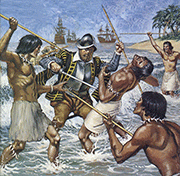E-Archive
Off the Beaten Track
in Vol. 18 - September Issue - Year 2017
The Spice Islands


“Recognizing the captain, so many turned upon him that they knocked his helmet off his head twice. Then, trying to lay hand on sword, he could draw it out but halfway, because he had been wounded in the arm with a bamboo spear. When the natives saw that, they all hurled themselves upon him. One of them wounded him on the left leg with a large cutlass. That caused the captain to fall face downward, when immediately they rushed upon him with iron and bamboo spears and with their cutlasses, until they killed our mirror, our light, our comfort, and our true guide. When they wounded him, he turned back many times to see whether we were all in the boats.”
***
This is the story of the first circumnavigation of the Earth and of the hardships and tragedies that befell that expedition.
The kingdoms of Spain and Portugal were among the most aggressive maritime powers in the late fifteenth and the sixteenth centuries. The discovery of America had whetted appetites for the treasures of faraway lands. Spices from Asia, such as black pepper, cinnamon, nutmeg, clove and ginger, were worth their weight in gold and were already known and highly prized in the West. However, these commodities reached Europe through Arab traders, whose sources were carefully-guarded secrets.
The Treaty of Tordesillas was signed in 1494 in order to stop the continuous fighting between Spain and Portugal over newly-discovered lands. It drew an imaginary line 370 leagues west of the Cape Verde islands, roughly corresponding to longitude 46°W. Completely ignoring the ambitions of other maritime powers, this treaty assigned to Portugal all lands east of this imaginary line and to Spain, all lands to the west.
The Portuguese explorer Ferdinand Magellan was born in 1480. As a student, he developed a passion for astronomy, cartography and celestial navigation. At the age of twenty-five, Magellan joined a fleet sailing to the Indian Ocean and participated in the battles that gave to Portugal control of sea routes and ports in eastern Africa, in India and in the Malay Peninsula.
After returning home, Magellan heard about the fabulous wealth that the Portuguese had found in the Spice Islands, now known as the Moluccas in present-day Indonesia. He also avidly studied reports and maps compiled by navigators exploring the coasts of America. Magellan became convinced that there must be a passage through the Americas providing a quicker and shorter route to the Spice Islands by sailing westwards.
Having fallen out of favor with the Portuguese king, Magellan approached the Spanish King Charles V, who jumped at the prospect of enormous riches from the Far East while at the same time respecting the tenets of the Treaty of Tordesillas, as his ships would be sailing westwards.
Five ships and 270 crew members set sail on the 20th of September 1519. After evading the Portuguese warships that had been sent by King Manuel I to stop the Spanish expedition, Magellan’s fleet reached South America in early December. Seeking the elusive passage on the east coast of South America, the explorers gradually reached Patagonia. When three captains mutinied, Magellan had two of them executed, while the third mutineer was marooned on the coast. After losing one of the ships in a violent storm, the fleet finally found the passage, later named the Strait of Magellan. 570 kilometers long, the strait proved to be a nautical nightmare, with tides up to seven meters and extremely strong winds and currents. During the crossing, one of the ships deserted and headed back to Spain. Magellan and his crew were the first Europeans to see the vast body of water that Magellan called Pacific, due to its relative calm compared to the turbulence of the strait.
Nobody could imagine the incredible distance they still had to cover. Thirst, scurvy and starvation killed many of the crew. Their first landfall was at Guam after ninety-nine days of sailing.
Tragedy struck when Ferdinand Magellan and many of his men were killed in a clash between local tribes in the Philippine Islands in April 1521. The episode was recorded by Antonio Pigafetta, a Venetian sailor who kept a meticulous journal of the voyage. The ships finally reached the Spice Islands in November. Under the command of Juan Sebastián Elcano, the fleet continued westward, losing two more ships along the way. The last remaining ship arrived in Spain in November 1522 with only eighteen members of the original crew. The twenty-six tons of spices it carried more than paid for the cost of the entire expedition.
By Giovanni Gregorat, Contributing Editor MFN
Author: Giovanni Gregorat



























